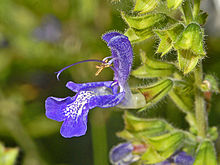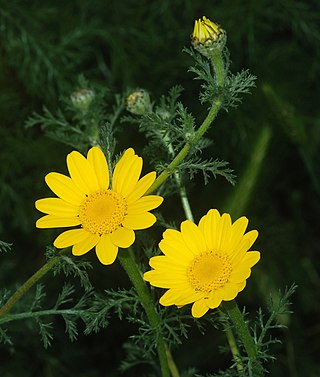
Cota tinctoria, the golden marguerite, yellow chamomile, or oxeye chamomile, is a species of perennial flowering plant in the sunflower family. Other common names include dyer's chamomile, Boston daisy, and Paris daisy. In horticulture this plant is still widely referred to by its synonym Anthemis tinctoria.
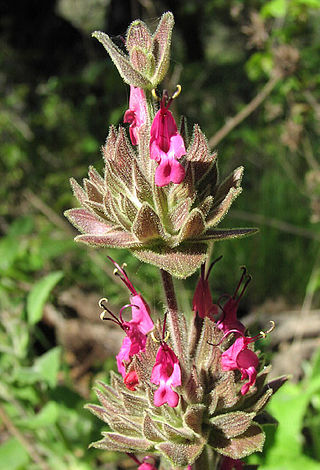
Salvia spathacea, the California hummingbird sage or pitcher sage, is a species of flowering plant in the family Lamiaceae, native to southern and central California growing from sea level to 610 m (2,001 ft). This fruity scented sage blooms in March to May with typically dark rose-lilac colored flowers. It is cultivated in gardens for its attractive flowering spikes and pleasant scent.

Salvia glutinosa, the glutinous sage, sticky sage, Jupiter's sage, or Jupiter's distaff, is a herbaceous perennial plant belonging to the family Lamiaceae.

Salvia leucophylla, the San Luis purple sage or gray sage, is an aromatic sage native to the southern coastal mountain ranges of the Californias.

Salvia pratensis, the meadow clary or meadow sage, is a species of flowering plant in the family Lamiaceae, native to Europe, western Asia and northern Africa. The Latin specific epithet pratensis means "of meadows", referring to its preferred habitat. It also grows in scrub edges and woodland borders.

Salvia sprucei is a herbaceous perennial in the family Lamiaceae that is native to Ecuador, growing at 7,000 feet (2,100 m) elevation or higher in thick scrub on steep slopes. It was named in 1898 by botanist John Isaac Briquet for the British plant collector Richard Spruce. It is likely that Spruce discovered the plant on a collecting trip in Ecuador in 1857.

Salvia fruticosa, or Greek sage, is a perennial herb or sub-shrub native to the eastern Mediterranean, including Southern Italy, the Canary Islands and North Africa. It is especially abundant in Palestine, Israel and Lebanon.
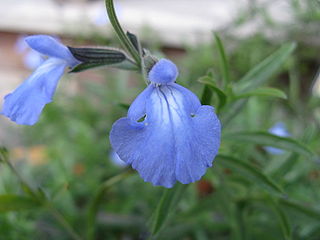
Salvia azurea, the azure blue sage, azure sage, blue sage or prairie sage, is a herbaceous perennial in the genus Salvia that is native to Central and Eastern North America.

Salvia farinacea, the mealycup sage, or mealy sage, is a herbaceous perennial native to Nuevo León, Mexico and parts of the United States including Texas and Oklahoma. Violet-blue spikes rest on a compact plant of typically narrow salvia-like leaves; however, the shiny leaves are what set this species apart from most other Salvia, which bear velvety-dull leaves.

Salvia confertiflora, the Sabra spike sage, is a species of flowering plant in the family Lamiaceae, native to Brazil. This herbaceous perennial reaches 1–1.5 m (3.3–4.9 ft) in height, and 10–50 cm (3.9–19.7 in) spread in one season, becoming shrubby at the base with age.

Salvia polystachia, also spelt Salvia polystachya, is a herbaceous perennial native to central Mexico and south through Central America into Panama, typically growing at elevations from 5,000 to 10,000 feet in mild climates where there is some summer rain. It one of the species used as chia and it is rarely seen in horticulture.
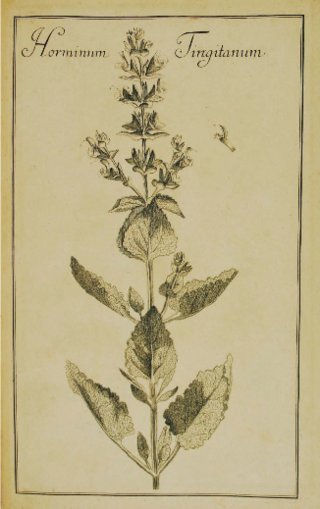
Salvia tingitana is an herbaceous perennial in the family Lamiaceae. It has a long and enigmatic history—it has been grown and described since the 17th century without any certainty about its origin. Botanists' speculation that it was native to northern Africa is reflected in the specific epithet tingitana, which refers to the town of "Tingi", even though no native plants have ever been found there. It was not until 1989 that a wild population of the plant was discovered, in western Saudi Arabia. The plant is regarded as a rather strong mosquito repellent commonly used in traditional medicine of Behbahan where it blooms around March.
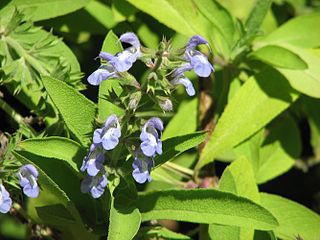
Salvia somalensis is a perennial shrub endemic to a limited range and elevation in Somalia. It grows at elevations from 4,000 feet (1,200 m) to 7,000 feet (2,100 m), typically in forest clearings or edges as a common or dominant subshrub.

Salvia taraxacifolia is a species of flowering plant in the Lamiaceae family. It is referred to by the common name Dandelion leaved sage and is a herbaceous perennial shrub that is endemic to southwest Morocco, growing in the Atlas Mountains at elevations ranging from 2,000 feet (610 m) to 8,000 feet (2,400 m). Very adaptable, it grows on limestone slopes, forest clearings, and rocky riversides. It has no close allies in the genus Salvia. The specific epithet, taraxacifolia, is likely Persian in origin and means 'leaves shaped like a dandelion'.
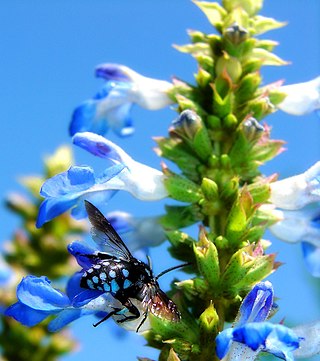
The plant known as Salvia uliginosa, the bog sage, is a species of flowering plant in the family Lamiaceae, native to southern Brazil, Uruguay, and Argentina. It was described and named by botanist George Bentham for its typical habitat "of swamps and marshes", or uliginosa.

Salvia villosa is a herbaceous perennial that is native to the Mexican states of San Luis Potosi and Coahuila, growing at approximately 4,000 feet (1,200 m) elevation in dry areas that have little or no frost.

Crepis tectorum, commonly referred to as the narrowleaf hawksbeard or narrow-leaved hawk's-beard, is an annual or winter annual plant between 30 and 100 centimetres in height. Originating in Siberia before being introduced to Canada in 1890, the narrowleaf hawksbeard's is an invasive species. Maintaining one branched, hairless and leafy stem during maturity, the narrowleaf hawksbeard has yellow leaves which are arranged in an alternate manner and less than 0.5 inches (13 mm) wide.

Iris aphylla is a species in the genus Iris, it is also in the subgenus Iris, and in the section Iris. It is a rhizomatous perennial, from Asia to Europe. It is found in Azerbaijan, Russian Federation, Czech Republic, Germany, Hungary, Poland, Belarus, Ukraine, Bulgaria, Albania, Former Yugoslavia, Italy, Romania and France. It has dark green or bright green, sword-shaped, long grass-like leaves, that die/fade away in the winter. It also has a slender stem, with several branches and green and purplish spathes. It has 3–5 large flowers, in shades of bright purple, purple, violet, dark blue, blue-violet and dark violet, which bloom between spring and early summer. Occasionally, they re-bloom in the autumn, before the seed capsule is formed. It is cultivated as an ornamental plant in temperate regions. There is one known subspecies Iris aphylla subsp. hungarica Hegi.
Iris adriatica is a plant species in the genus Iris, it is also in the subgenus Iris. It is a rhizomatous perennial, from the Dalmatia region of Croatia in Europe. It has short sickle shaped leaves, small stem and flowers that vary from yellow to purple or violet. It is rarely cultivated as an ornamental plant in temperate regions.

Symphyotrichum molle is a species of flowering plant in the aster family (Asteraceae) endemic to the Bighorn Mountains of Montana and Wyoming in the United States. Commonly known as soft aster, it is a perennial, herbaceous plant that ranges from 30 to 60 centimeters in height.
